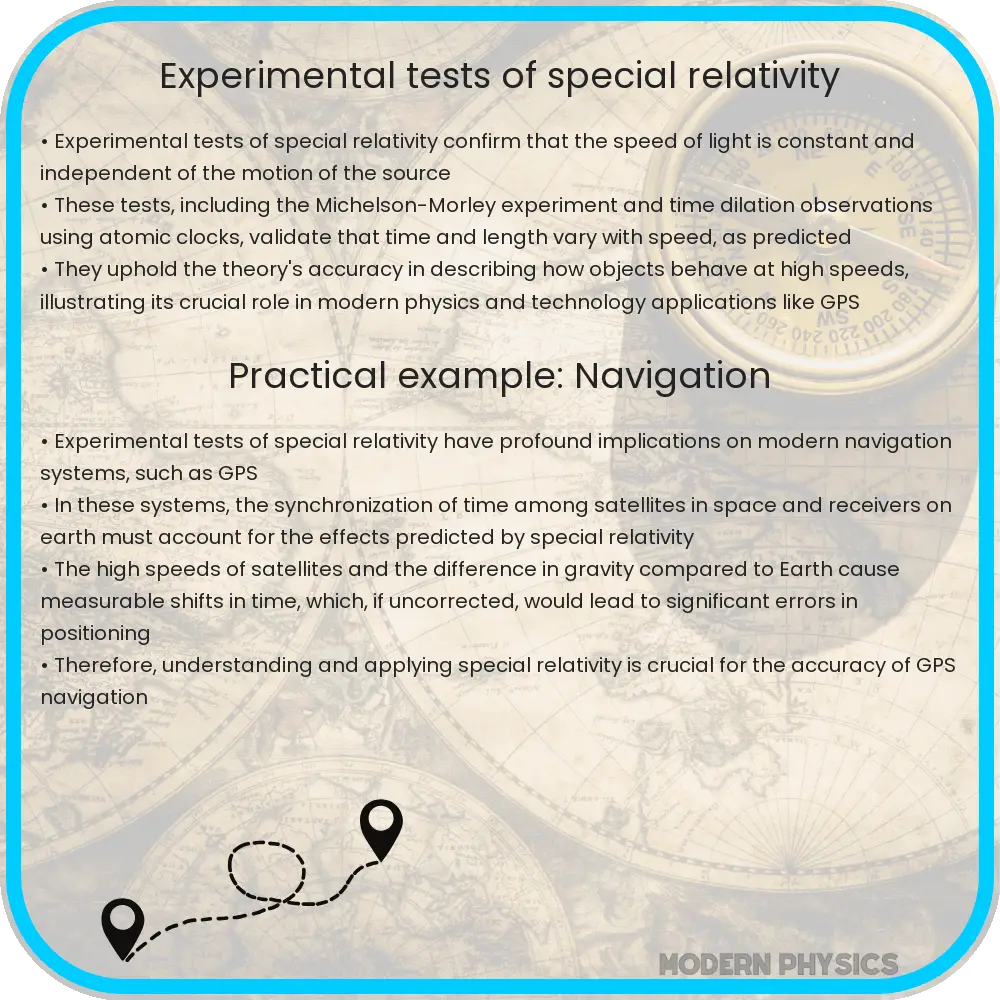Detailed overview of experimental tests of Special Relativity, examining methods like time dilation in particle physics, GPS verification, and the Michelson-Morley experiment.

Experimental Tests of Special Relativity | Accuracy, Results & Methods
Special Relativity, formulated by Albert Einstein in 1905, revolutionized our understanding of space, time, and motion. Yet, like any scientific theory, it must stand the test of experimental verification. Since its inception, numerous experiments have been conducted to confirm its predictions with remarkable accuracy. This article explores the methods, results, and accuracy of these experimental tests.
Methods of Testing Special Relativity
Testing Special Relativity involves examining several of its key predictions, including the constancy of the speed of light, time dilation, and length contraction, as well as the equivalence of mass and energy. Here are some methods used to test these predictions:
Time Dilation in Particle Physics
One of the most striking aspects of Special Relativity is time dilation, where time slows down for a moving observer relative to a stationary one. Particle accelerators provide a natural setting to test this phenomenon. For example, muons (elementary particles) produced in cosmic-ray interactions have a very short lifespan. At rest, they decay in about 2.2 microseconds. However, when these muons travel close to the speed of light, their decay time appears extended due to time dilation.
Let’s denote the time observed in the laboratory as t’ and the proper time (time in the muon’s frame) as t. According to Special Relativity:
t’ = t / sqrt(1 – (v2/c2))
where:
Experimental observations match this prediction with high precision, confirming the time dilation effect.
Michelson-Morley Experiment
The Michelson-Morley experiment, conducted in 1887, aimed to detect the presence of “ether,” a medium through which light was once thought to travel. The experiment used an interferometer to compare the speed of light in perpendicular directions. Surprisingly, no difference was found, indicating that the speed of light is constant in all directions, which aligns perfectly with Special Relativity.
Tests of E=mc2
Einstein’s famous equation E=mc2 states that energy (E) and mass (m) are interchangeable, with c being the speed of light in a vacuum. This equation implies that even a small amount of mass can be converted into a large amount of energy. Nuclear reactions, both fission and fusion, along with particle collider experiments, have consistently verified this relationship to an extraordinary degree of accuracy.
Global Positioning System (GPS) Verification
The Global Positioning System (GPS) relies on a constellation of satellites equipped with precise atomic clocks. To provide accurate positioning data, the system must account for both Special and General Relativity. The satellites are in motion relative to observers on Earth (Special Relativity) and also experience different gravitational fields (General Relativity), affecting the flow of time. Correcting for these relativistic effects is essential for the system’s accuracy and provides a real-world confirmation of Einstein’s theories.
Experimental Evidence from Atomic Clocks
One of the intriguing tests of Special Relativity involves highly accurate atomic clocks. In these experiments, synchronized atomic clocks are subjected to different velocities and gravitational strengths. For instance, an atomic clock flown around the Earth in an airplane will experience time differently compared to a stationary clock on the ground. This is due to the combined effects of Special and General Relativity.
The famous Hafele-Keating experiment conducted in 1971 flew atomic clocks around the world on commercial airliners. Upon their return, the airborne clocks were found to be slightly behind the stationary clocks, consistent with the predictions of both Special and General Relativity.
Particle Accelerators and High-Energy Tests
Particle accelerators such as the Large Hadron Collider (LHC) are essentially laboratories for high-energy physics, where particles are accelerated to near-light speeds. These high velocities provide a perfect setting to test predictions of mass-energy equivalence and relativistic momentum.
When particles collide at high speeds, the energy that was used to accelerate them is converted into mass, creating new particles. The results from these collisions have consistently confirmed Einstein’s equation E=mc2 and the principles of energy and momentum conservation under Special Relativity.
High-Precision Laser Experiments
Modern laser technology allows for extremely precise measurements that can test the limits of Special Relativity. One notable example is the use of ring lasers and optical cavities to measure the constancy of the speed of light. These experiments have repeatedly shown that the speed of light remains consistent across various orientations and velocities, supporting the theory’s postulate that the speed of light is invariant regardless of the inertial reference frame.
Conclusion
Over more than a century, Special Relativity has undergone extensive experimental scrutiny. From the early Michelson-Morley experiment to modern particle accelerators and atomic clock tests, each method has consistently confirmed the theory’s predictions with incredible accuracy. Whether it’s time dilation observed in high-speed muons, energy-mass equivalences in nuclear reactions, or the everyday confirmation provided by GPS systems, these experimental results have cemented Special Relativity as a cornerstone of modern physics. As technology advances, new and more precise tests continue to affirm Einstein’s revolutionary ideas, ensuring that Special Relativity remains an integral part of our understanding of the universe.
